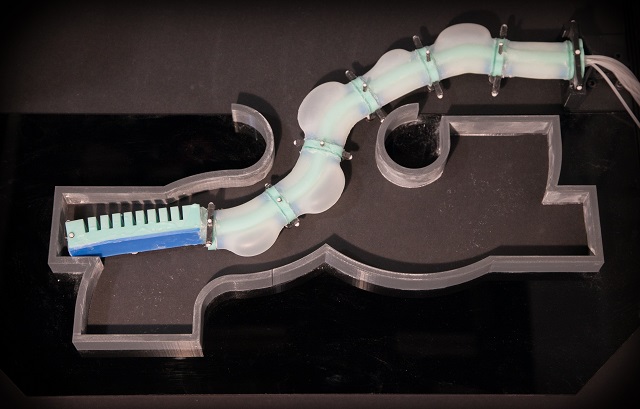 CSAIL团队的橡胶机器人手臂使用加压空气移动,这会导致其像气球一样改变形状。照片:杰森·多夫曼(Jason Dorfman),Csail
CSAIL团队的橡胶机器人手臂使用加压空气移动,这会导致其像气球一样改变形状。照片:杰森·多夫曼(Jason Dorfman),Csail
科学家Computer Science and Artificial Intelligence Lab (CSAIL) of MIT已经设计了一个柔软的机器人臂,能够通过类似于蛇的管道状结构滑行。手臂设计与章鱼触角相似。
3D-printed molds were used to fabricate the arm, which is the latest project done by the CSAIL research group headed by Director Daniela Rus. The group has been working on soft robots that are more effective, resilient, and safe for specific tasks when compared to their rigid counterparts. Soft robots can also fit into tight spots and move in a more agile manner.
Andrew Marchese, a doctoral candidate, led the research and Robert Katzschmann, a PhD student, and Daniela Rus were part of the research. Complicated algorithms were developed to determine the body curvature required for the robot to make different movements.
例如,要克服一些挑战,例如,确定将机器人带到空间特定点所需的特定弯曲弧,尤其是在管道等密闭区域中。
CSAIL机器人手臂上的绑带,就像蛇穿过管道一样
Csail机器人手臂像蛇一样通过管道。视频:CSAIL
The softness of the robotic arm prevented the attachment of a typical motor shaft. Instead, expandable, hollow channels were designed on either side of the arm which, when filled with air, applied strain on the silicone. This caused changes in shape similar to a balloon, enabling bending of the arm to one side.
The 100% silicone rubber arm is another distinct feature that challenged the researchers to develop appropriate programming to enable the robot’s highly soft body to adapt easily to moving in human environments.
The arm has the potential to be used in handling of delicate specimens, assisting in certain types of surgery and in precisely tuned tasks in factories. The future version of the robotic arm will have a finger-gripper for picking and placing objects.